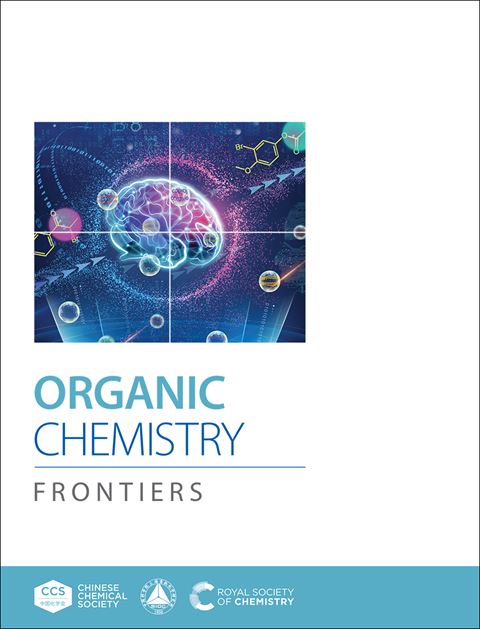金催化中的立体和分散效应:不对称环化/曼尼希反应的DFT研究
IF 4.7
1区 化学
Q1 CHEMISTRY, ORGANIC
引用次数: 0
摘要
金配合物与手性磷酸(CPA)之间的协同催化作用实现了同丙炔酰胺的不对称氧化环化/曼尼希反应,提供了具有高对映选择性的手性螺络啉的有效途径。然而,机理细节,特别是由空间和色散效应相互作用支配的立体控制的起源,仍然是难以捉摸的。在此,我们提出了一个全面的密度泛函理论(DFT)研究来揭示反应机理和控制对映体选择性的决定性因素。我们的计算表明,催化循环通过金-碳的形成、区域选择性的N-H插入、烯醇化和立体决定的曼尼希加成进行。对映体选择性主要由曼尼希步骤决定,在曼尼希步骤中,有利的过渡态(TS-SR)由非共价相互作用的协同网络稳定,包括磺胺基团和CPA催化剂之间的氢键和分散力。定量的扭曲-相互作用分析表明,色散相互作用对非对映体过渡态之间的能量差有显著贡献(~3.0 kcal/mol)。该研究不仅明确了立体化学模型,而且为今后金/CPA协同催化中催化剂的设计提供了合理的依据。本文章由计算机程序翻译,如有差异,请以英文原文为准。
Unraveling Steric and Dispersion Effects in Gold Catalysis: A DFT Study of Asymmetric Cyclization/Mannich Reactions
The cooperative catalysis between gold complexes and chiral phosphoric acids (CPA) enables asymmetric oxidative cyclization/Mannich reactions of homopropargyl amides, providing efficient access to chiral spiroindolenines with high enantioselectivity. However, the mechanistic details, particularly the origin of stereocontrol governed by the interplay of steric and dispersion effects, remain elusive. Herein, we present a comprehensive density functional theory (DFT) study to unravel the reaction mechanism and the decisive factors controlling enantioselectivity. Our computations reveal that the catalytic cycle proceeds through gold-carbene formation, regioselective N-H insertion, enolization, and the stereodetermining Mannich addition. The enantioselectivity is primarily dictated by the Mannich step, wherein the favored transition state (TS-SR) is stabilized by a synergistic network of noncovalent interactions, including hydrogen bonding and dispersion forces between the sulfonamide group and the CPA catalyst. Quantitative distortion-interaction analysis demonstrates that dispersion interactions contribute significantly (~3.0 kcal/mol) to the energy difference between diastereomeric transition states. This study not only clarifies the stereochemical model but also provides a rational basis for future catalyst design in gold/CPA cooperative catalysis.
求助全文
通过发布文献求助,成功后即可免费获取论文全文。
去求助
来源期刊

Organic Chemistry Frontiers
CHEMISTRY, ORGANIC-
CiteScore
7.90
自引率
11.10%
发文量
686
审稿时长
1 months
期刊介绍:
Organic Chemistry Frontiers is an esteemed journal that publishes high-quality research across the field of organic chemistry. It places a significant emphasis on studies that contribute substantially to the field by introducing new or significantly improved protocols and methodologies. The journal covers a wide array of topics which include, but are not limited to, organic synthesis, the development of synthetic methodologies, catalysis, natural products, functional organic materials, supramolecular and macromolecular chemistry, as well as physical and computational organic chemistry.
 求助内容:
求助内容: 应助结果提醒方式:
应助结果提醒方式:


